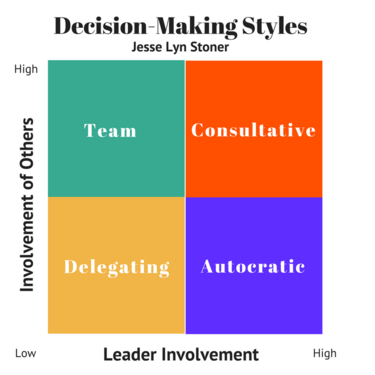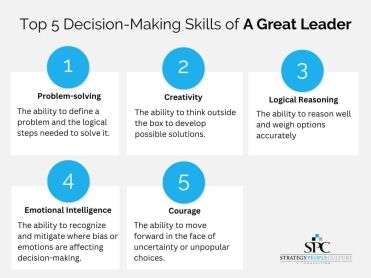Decision Making for Leaders
Introduction to Decision Making in Leadership
In the fast-paced and ever-evolving world of business, effective decision making stands as a cornerstone of successful leadership. Leaders are often faced with complex situations that require them to make choices quickly and confidently. The ability to make sound decisions can significantly impact an organization’s success, influencing everything from team morale to overall profitability.

In this article, we will explore various aspects of decision making for leaders, including the types of decisions they make, the models they employ, and the factors that influence their choices. We’ll also provide effective strategies to enhance decision-making capabilities.
The Importance of Decision Making for Leaders
Decision making is critical for leaders for several reasons:
- Direction Setting: Leaders set the course for their organizations. Their decisions determine the direction of teams and projects, guiding employees toward common goals.
- Resource Allocation: Effective decision making ensures that resources, such as time and finances, are allocated wisely, maximizing organizational efficiency.
- Risk Management: Leaders face numerous risks in their roles. Making informed decisions helps mitigate potential negative outcomes, enabling leaders to navigate challenges successfully.
Types of Decisions Leaders Make
Leaders encounter various types of decisions that can be broadly categorized as follows:
- Strategic Decisions: These involve long-term planning and overall direction for the organization, affecting its future and positioning in the market.
- Operational Decisions: Focused on day-to-day operations, these decisions ensure that processes run smoothly and efficiently.
- Tactical Decisions: Often made in response to changing circumstances, tactical decisions are short-term and aim to address immediate needs.
Common Decision-Making Models
Leaders can employ several decision-making models to enhance their effectiveness. Understanding these models helps leaders choose the best approach for their situation.
1. Rational Decision-Making Model
The Rational Decision-Making Model is a systematic approach where leaders follow a series of steps to arrive at a logical decision. The steps typically include:
- Identifying the problem
- Gathering information
- Developing alternatives
- Evaluating the options
- Making the decision
- Implementing the decision
- Monitoring and reviewing the outcomes
This model emphasizes a structured process, promoting thorough analysis and informed choices.
2. Bounded Rationality
Recognizing that not all decisions can be made with complete information, the concept of Bounded Rationality comes into play. This model suggests that leaders make decisions based on the limited information available to them and within the constraints of their cognitive capabilities. Instead of seeking the optimal solution, leaders aim for a satisfactory one that meets their requirements.
3. Intuitive Decision Making
Intuitive Decision Making relies on a leader’s gut feelings and instincts. While this approach may lack a systematic framework, it can be effective, especially in time-sensitive situations where quick judgments are necessary. Leaders with extensive experience often develop intuition that guides their decisions.
4. Evidence-Based Decision Making
In an era where data plays a critical role in organizational success, Evidence-Based Decision Making focuses on using empirical evidence to inform choices. This approach emphasizes gathering relevant data, assessing its validity, and integrating it into the decision-making process.
Factors Influencing Decision Making
Leaders must navigate various factors that can impact their decision-making processes. Understanding these influences is crucial for effective leadership.
1. Emotional Intelligence in Decision Making
Emotional intelligence (EI) is a key factor that affects how leaders make decisions. Leaders with high emotional intelligence can recognize their own emotions and those of others, enabling them to approach decisions with empathy and understanding. This ability to manage emotions fosters better relationships within teams and contributes to more balanced decision-making.
2. Organizational Culture and Environment
The organizational culture significantly influences decision making. A culture that encourages open communication and collaboration often leads to more effective decisions. Conversely, a hierarchical or rigid culture may stifle creativity and hinder the decision-making process.
3. Time Constraints and Urgency
Leaders frequently operate under tight deadlines, which can affect their decision-making processes. Time constraints may force leaders to rely on quicker, less thorough methods, potentially compromising the quality of their decisions. Understanding the urgency of each situation can help leaders balance thoroughness with efficiency.
4. Cognitive Biases
Cognitive biases, such as confirmation bias or anchoring bias, can cloud judgment and lead to poor decisions. Leaders must be aware of these biases and actively work to minimize their impact on the decision-making process.
Effective Decision-Making Strategies for Leaders
To navigate the complexities of decision making, leaders can employ several strategies:
1. Define Clear Objectives
Before making any decision, leaders should define clear objectives. Understanding what they aim to achieve helps ensure that their decisions align with the organization’s goals.
2. Gather Relevant Information
Effective decision making relies on accurate and relevant information. Leaders should invest time in gathering data from various sources, including team members, market research, and industry trends.
3. Evaluate Alternatives
Exploring multiple options is critical. Leaders should weigh the pros and cons of each alternative to identify the best possible solution.
4. Involve the Team in the Process
Collaborating with team members can yield valuable insights and foster a sense of ownership. Engaging the team encourages diverse perspectives and can lead to more innovative solutions.
5. Learn from Past Decisions
Reflection is essential for growth. Leaders should take time to analyze past decisions, identifying what worked and what didn’t. This practice allows them to refine their decision-making skills over time.
In the second half of the article, we will explore the role of technology in decision making, concluding with key takeaways and frequently asked questions to further enhance your understanding of effective decision-making strategies for leaders.
The Role of Technology in Decision Making
In today’s digital age, technology plays an increasingly critical role in the decision-making processes of leaders. Here are some ways technology can enhance decision making:
1. Data Analytics
Leaders can harness the power of data analytics to derive insights from large volumes of information. Advanced analytics tools can help identify trends, forecast outcomes, and support informed decision making. For example, predictive analytics can provide leaders with foresight into potential market changes, allowing them to make proactive decisions.
2. Collaboration Tools
Technology has transformed how teams collaborate. Collaboration tools such as Slack, Microsoft Teams, and Asana facilitate real-time communication and project management. These platforms enable leaders to engage their teams in the decision-making process, ensuring that diverse perspectives are considered.
3. Decision Support Systems (DSS)
Decision Support Systems (DSS) integrate data from various sources to assist leaders in making more informed choices. These systems provide relevant information, simulation models, and analytical tools to evaluate different scenarios and potential outcomes. By leveraging DSS, leaders can reduce uncertainty and enhance their decision-making capabilities.
4. Artificial Intelligence (AI)
The advent of Artificial Intelligence has revolutionized decision making. AI can process vast amounts of data far more quickly than humans, identifying patterns and providing recommendations based on predictive models. Leaders can utilize AI to enhance strategic planning and operational efficiency.
Key Takeaways
To sum up, effective decision making is a multifaceted skill that leaders must continually develop. By employing structured decision-making models, understanding the factors that influence their choices, and leveraging technology, leaders can enhance their decision-making capabilities. Here are the key takeaways:
- Understand the Types of Decisions: Recognize whether your decision is strategic, operational, or tactical.
- Use Appropriate Decision-Making Models: Familiarize yourself with models like Rational Decision-Making, Bounded Rationality, and Evidence-Based Decision Making.
- Acknowledge Influencing Factors: Emotional intelligence, organizational culture, and cognitive biases play a significant role in decision making.
- Adopt Effective Strategies: Define clear objectives, gather relevant information, and involve your team in the process.
- Embrace Technology: Utilize data analytics, collaboration tools, DSS, and AI to support informed decisions.
FAQs about Decision Making for Leaders
Q1: What are some common pitfalls in decision making?
Some common pitfalls include analysis paralysis, where leaders become overwhelmed by data and fail to make a decision, and confirmation bias, where they seek out information that supports their preconceived notions while ignoring contradictory evidence.
Q2: How can leaders improve their decision-making skills?
Leaders can improve their skills by actively seeking feedback, reflecting on past decisions, engaging in training and development programs, and remaining open to different perspectives.
Q3: Is it better to rely on intuition or data when making decisions?
Both intuition and data have their merits. While intuition can be valuable, especially in high-pressure situations, relying on data ensures decisions are grounded in factual evidence. The best approach is to balance both.
Q4: How can emotional intelligence enhance decision-making capabilities?
Leaders with high emotional intelligence can better understand their emotions and those of others, enabling them to make more empathetic and informed decisions. This understanding fosters trust and collaboration within teams.
Q5: What role does organizational culture play in decision making?
Organizational culture shapes the decision-making environment. A culture that encourages open dialogue, collaboration, and innovation supports more effective decision-making processes, while a rigid culture can hinder creativity and lead to poor outcomes.

Conclusion
In conclusion, mastering decision making is essential for effective leadership. By understanding various decision-making models, recognizing the factors that influence their choices, and utilizing technology, leaders can enhance their ability to make informed, strategic decisions that drive organizational success. Embracing continuous learning and adaptability in decision-making practices will empower leaders to navigate the complexities of their roles confidently.
For more insights on leadership and decision-making, check out resources from the Harvard Business Review and the Corporate Finance Institute.

By incorporating these principles and practices into your leadership toolkit, you’ll be better equipped to make decisions that foster growth and innovation within your organization.

